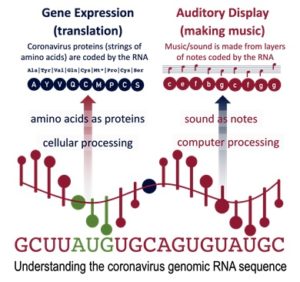
I recently wrote an article for BMC describing the use of sound to describe the function of the coronavirus genome. It was a perplexing article to write since I was toing and froing about science and art. I was writing a science article which had an art component to it. Was I creating a technical auditory display or was I creating something that was musical? I think I was actually doing both. I have since realised that I was adding an ‘A for Art’ into Science Technology Engineering and Maths to make STE(A)M. I made something that is both functional and creative. I thought if it didn’t sound good then people would not use it as a science tool.
Amongst other things I have been making audio by copying the way a biological cell makes proteins

I also created an animated display which is synchronised to the audio. The animation scrolls the genomic sequence across the page as if it was interacting with proteins inside a human cell. I did this because I want the user to see the sequence pass by as you hear the audio. Our eyes are attracted to things that move and we naturally listen for patterns in what we hear. I thought the combination of the two would be greater than either in isolation. The music is never going to replace a well-designed (but silent) genome browser but an audio track that is synchronised to a visual browser may help interpret the complex genomic sequences.
Video: https://youtu.be/2U8pMNuOdJM
What is the music trying to say?
For the purpose of this discussion let’s assume that I have used the coronavirus genome to make instrumental music, since this is often what is assumed. So, the question now is, what is the music trying to say? If it were composed by a human it might say something about the human condition in response to the virus. But the music was composed by a computer algorithm from the genomic sequence and therefore it tells us something about the function of the genome. It tells us something about how the genome is used to make proteins (translation) and how it makes new copies of itself (transcription).
Imagine you are inside a human cell.
To understand the music, you need to imagine that you are inside a human cell, you are a machine (such as a ribosome complex) moving along the viral genomic RNA sequence and converting it into a protein sequence, like a train running down a track. The music of translation begins at a slow tempo whilst we listen to an untranslated region. As we run into a gene sequence, another instrument starts to play the sound of a new protein being made and the music picks tempo up. Occasionally the music pauses in silence as we pass a cleavage point in a coronavirus protein. Almost randomly, syncopated high pitched notes sound out as we pass important regions called stop codons. Conversely, the effect of a start codon may be heard for many minutes after the text sequence has scrolled off the screen. The sound of these and other genomic attributes gives a narrative to the music.
If we are to use colors, shapes and font styles to tell us something about the sequence, then why not use music to tell us this is a new way? The fact that music has a beginning, middle and end is important since this makes us think about the order of features in the genome and this is important to understand their function.
Is the sound musical in its own right?
For days after I submitted the manuscript for review I had the ‘so called music’ of the coronavirus genome in my head. I was wondering if other people would also consider it musical. Music can be inspiring, it should be creative and it can stir human emotion. In contrast, the sound of the coronavirus genome is minimal, repetitive and systematic. To make genomic data more musical I thought I should add some musicians into the mix. Literally!
A musician friend of mine (Mike Anderson) and I went into the music studio. We played the sound of the coronavirus genome very loudly over a big sound system. We set up drums and a loud guitar amp and we played along with the sequence. I made a simple recording of this and called it Coronacode music.
Video: https://youtu.be/2sG9O300Oz0
After producing Coronacode music it made me think more about generative music (from a computer) versus musical improvisation. When we played along to the code it restricted what we were able to play and this constraint was a source of creativity. It snapped us out of our usual musical patterns and made us play something new. The repeating nucleotides A, U, G and C combine with the repeating drum pattern of kick, snare, tom, kick! Long guitar tones soften the incessant pulse of the coronavirus.
Growing up in public.
This approach is new to me. I think the use of sound to convey patterns in scientific data (sonification) has not yet come of age. Anecdotally I would say there is still skepticism within the scientific community regarding the value of sound. However, since computer browsers are now more capable to process data into audio and visuals I think we will see more instances of its application. If the audio and visual displays are tightly coupled and work together in harmony, then I think it will not only sound good but it will be more informative.
Comments